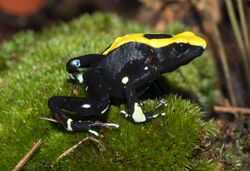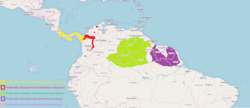Biology:Dendrobates
| Dendrobates | |
|---|---|

| |
| Dendrobates tinctorius | |
| Scientific classification | |
| Domain: | Eukaryota |
| Kingdom: | Animalia |
| Phylum: | Chordata |
| Class: | Amphibia |
| Order: | Anura |
| Family: | Dendrobatidae |
| Subfamily: | Dendrobatinae |
| Genus: | Dendrobates Wagler, 1830 |
| Type species | |
| Dendrobates tinctorius Cuvier, 1797
| |
| Diversity | |
| 5 species (see text) | |

| |
| Distribution of the five Dendrobates species | |
Dendrobates is a genus of poison dart frogs native to Central and South America. It once contained numerous species, but most originally placed in this genus have been split off into other genera such as Adelphobates, Ameerega, Andinobates, Epipedobates, Excidobates, Oophaga, Phyllobates and Ranitomeya (essentially all the brightly marked poison dart frogs; i.e. excluding the duller genera in the family like Colostethus and Hyloxalus), leaving only five large to medium-sized species in the genus Dendrobates.[1][2] All the other genera used to be grouped in with Dendrobates because it was previously thought that all brightly colored poison dart frogs came from the same ancestor but this has since been proven to be incorrect.[3] Dendrobates and Phyllobates evolved conspicuous coloration from the same common ancestor but not the same as any of the other genera listed above.[4]
There is accumulating evidence that Dendrobates are diet specialists and sequester the toxin found on their skin from their diet. It has been found that diet specialization evolved in tandem with conspicuous coloration in the case of Dendrobates.[5]
The generic name Dendrobates is derived from grc δένδρον déndron 'tree', and βάτης bátēs 'one that treads', meaning ‘tree climber’.[6]
Species
| Image | Common name | Binomial name and authority[7] | Distribution |
|---|---|---|---|
 |
Green and black poison dart frog | Dendrobates auratus (Girard, 1855) | southeastern Nicaragua on the Atlantic slope and southeastern Costa Rica on the Pacific coast through Panama to northwestern Colombia (Chocó Department) |
 |
Yellow-banded poison dart frog | Dendrobates leucomelas Steindachner, 1864 | Guyana, Brazil, Venezuela and the extreme easternmost part of Colombia |
| Rockstone poison dart frog | Dendrobates nubeculosus Jungfer and Böhme, 2004 | near Rockstone, Guyana | |
 |
Dyeing poison dart frog | Dendrobates tinctorius (Cuvier, 1797) | Guiana Shield, including parts of Guyana, Suriname, Brazil, and nearly all of French Guiana. |
 |
Yellow-striped poison dart frog | Dendrobates truncatus (Cope, 1861) | Colombia |
References
- ↑ Grant, T.; Frost, D. R.; Caldwell, J. P.; Gagliardo, R.; Haddad, C. F. B.; Kok, P. J. R.; Means, D. B.; Noonan, B. P. et al. (2006). "Phylogenetic systematics of dart-poison frogs and their relatives (Amphibia: Athesphatanura: Dendrobatidae)". Bulletin of the American Museum of Natural History 299 (299): 1–262. doi:10.1206/0003-0090(2006)299[1:PSODFA2.0.CO;2].
- ↑ Frost, Darrel R. (2020). "Dendrobatidae". American Museum of Natural History, New York. http://research.amnh.org/herpetology/amphibia/Amphibia/Anura/Dendrobatidae.
- ↑ Santos, Juan Carlos; Coloma, Luis A.; Cannatella, David C. (2003-10-28). "Multiple, recurring origins of aposematism and diet specialization in poison frogs". Proceedings of the National Academy of Sciences of the United States of America 100 (22): 12792–12797. doi:10.1073/pnas.2133521100. ISSN 0027-8424. PMID 14555763.
- ↑ Carvajal-Castro, Juan D.; Vargas-Salinas, Fernando; Casas-Cardona, Santiago; Rojas, Bibiana; Santos, Juan C. (2021-09-24). "Aposematism facilitates the diversification of parental care strategies in poison frogs". Scientific Reports 11 (1): 19047. doi:10.1038/s41598-021-97206-6. ISSN 2045-2322. PMID 34561489. PMC 8463664. Bibcode: 2021NatSR..1119047C. http://dx.doi.org/10.1038/s41598-021-97206-6.
- ↑ Santos, Juan Carlos; Coloma, Luis A.; Cannatella, David C. (2003-10-28). "Multiple, recurring origins of aposematism and diet specialization in poison frogs". Proceedings of the National Academy of Sciences of the United States of America 100 (22): 12792–12797. doi:10.1073/pnas.2133521100. ISSN 0027-8424. PMID 14555763.
- ↑ Dodd, C. Kenneth (2013). Frogs of the United States and Canada. 1. The Johns Hopkins University Press. p. 20. ISBN 978-1-4214-0633-6. https://books.google.com/books?id=2Hwfz9P9gS0C&pg=PR20.
- ↑ Frost, Darrel R. (2014). "Dendrobates Wagler, 1830". Amphibian Species of the World: an Online Reference. Version 6.0. American Museum of Natural History. http://research.amnh.org/vz/herpetology/amphibia/Amphibia/Anura/Dendrobatidae/Dendrobatinae/Dendrobates.
Wikidata ☰ Q683090 entry
 |

